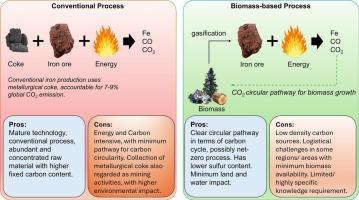Toward decarbonization in steelmaking: A review on direct reduced iron using biomass-based syngas
IF 7
2区 工程技术
Q1 ENERGY & FUELS
Sustainable Energy Technologies and Assessments
Pub Date : 2025-09-04
DOI:10.1016/j.seta.2025.104554
引用次数: 0
Abstract
The steel industry, responsible for 7–9 % of global CO2 emissions, faces increasing pressure to decarbonize its process. This review explores the potential of biomass-based syngas as a sustainable alternative to fossil fuels in direct reduced iron (DRI) production, drawing on previous research, and presents a thermodynamic analysis. Biomass gasification generates syngas rich in hydrogen (H2) and carbon monoxide (CO), which are the main reducing agents for the iron oxide to produce iron. Thermodynamic analysis reveals that CO is more effective for reduction at lower temperatures, while H2 becomes favorable at temperatures above 1088 K. However, challenges such as biomass availability, variability in syngas composition produced, and impurities in the solid and gas phases (e.g., H2S, N2, and phosphorus) hinder widespread adoption. Current commercial DRI plants, like MIDREX and HYL/Energiron, primarily use natural gas, but biomass-derived syngas offers a promising pathway for decarbonization. This review provides important insights into biomass utilization for iron production via the direct reduction route and several challenges that need to be addressed to improve the adoption of the technology. It was found that biomass-derived syngas is a highly promising source in the DRI process, especially in terms of energy security, metallization, and carbon content. However, it faces several challenges toward realization, including inconsistent syngas composition/quality, syngas impurities, scaling up, capital investment, and operational cost. Further research and innovation are crucial to improve the performance, stabilize syngas quality, and make biomass utilization in DRI production a competitive option.

炼钢脱碳之路:生物质合成气直接还原铁研究进展
占全球二氧化碳排放量7 - 9%的钢铁行业面临着越来越大的脱碳压力。本文在借鉴前人研究的基础上,探讨了生物质合成气作为化石燃料直接还原铁(DRI)生产的可持续替代品的潜力,并进行了热力学分析。生物质气化产生富含氢(H2)和一氧化碳(CO)的合成气,这是氧化铁生成铁的主要还原剂。热力学分析表明,CO在较低温度下更有利于还原,而H2在1088 K以上的温度下更有利于还原。然而,诸如生物质可利用性、合成气组成的可变性以及固相和气相中的杂质(例如H2S、N2和磷)等挑战阻碍了该技术的广泛应用。目前的商业DRI工厂,如MIDREX和HYL/Energiron,主要使用天然气,但生物质衍生合成气为脱碳提供了一个很有前途的途径。这篇综述为通过直接还原路线生产铁的生物质利用提供了重要的见解,以及需要解决的几个挑战,以提高该技术的采用。研究发现,生物质合成气在DRI过程中是一个非常有前途的来源,特别是在能源安全、金属化和碳含量方面。然而,它在实现过程中面临着一些挑战,包括不一致的合成气成分/质量、合成气杂质、规模、资本投资和运营成本。进一步的研究和创新对于提高性能,稳定合成气质量以及使生物质利用在DRI生产中具有竞争力至关重要。
本文章由计算机程序翻译,如有差异,请以英文原文为准。
求助全文
约1分钟内获得全文
求助全文
来源期刊

Sustainable Energy Technologies and Assessments
Energy-Renewable Energy, Sustainability and the Environment
CiteScore
12.70
自引率
12.50%
发文量
1091
期刊介绍:
Encouraging a transition to a sustainable energy future is imperative for our world. Technologies that enable this shift in various sectors like transportation, heating, and power systems are of utmost importance. Sustainable Energy Technologies and Assessments welcomes papers focusing on a range of aspects and levels of technological advancements in energy generation and utilization. The aim is to reduce the negative environmental impact associated with energy production and consumption, spanning from laboratory experiments to real-world applications in the commercial sector.
 求助内容:
求助内容: 应助结果提醒方式:
应助结果提醒方式:


